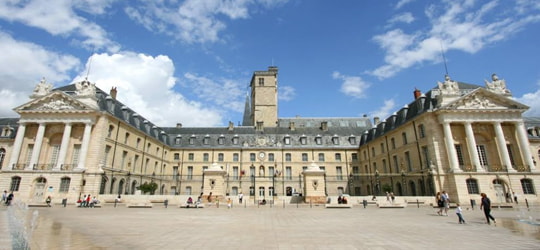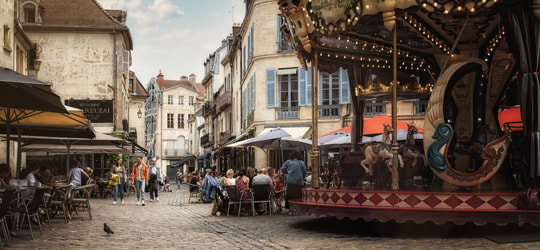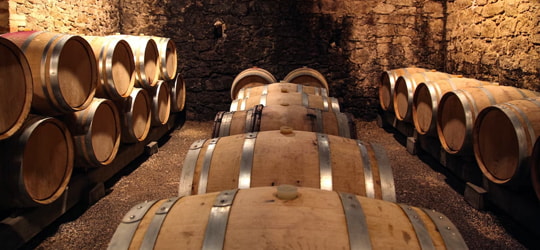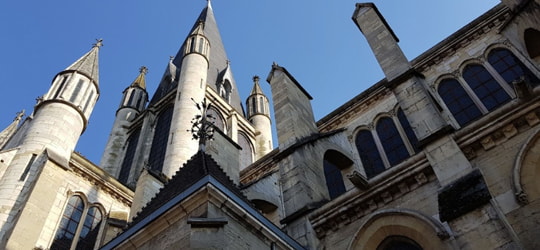
Must-sees in Burgundy – What to do, what to see, what to visit?
Dijon is the capital of the Burgundy-Franche-Comté region, located in central-eastern France. Crowned with the label “Ville d’art et d’histoire” (City of Art and History), it has a vast 97-hectare protected area.
The latter is now listed as a UNESCO World Heritage Site as part of the Climats du vignoble de Bourgogne.

The Palace of the Dukes of Burgundy
Located in the heart of the city, the Palace of the Dukes and States of Burgundy remains the most emblematic monument of Dijon. In the center, it houses the town hall topped by the by the Philippe le Bon tower. The 15th century lookout offers a panoramic view of the city of a hundred steeples from a height of 46 meters.
The Museum of Fine Arts has occupied the eastern wing of the palace since 1799. Completely renovated, it presents a collection of 1500 works of art spread over 50 rooms. It is among the richest of French museums.

The International City of
gastronomy and wine
Gastronomic capital and wine city, Dijon is famous for its culinary specialties: mustard, snails, crème de cassis, chocolate and gingerbread…
Located in the heart of the city, the International City of Gastronomy and Wine offers hundreds of experiences to live and taste: exhibitions, gastronomic village, wine tasting, workshops, restaurants, cinema…

Climbing the Philippe le Bon Tower
Built in the center of the Palace of the Dukes of Burgundy, the trapezoidal tower built in the 15th century has a spiral staircase with 316 steps. But don’t worry, we don’t climb all the steps at once! The first three levels of the seven floors of the tower distribute the different levels of the former ducal residence. Above are the ceremonial rooms which had no other purpose than to show the power of the Dukes of Valois.
The stop at the 199 th step allows you to catch your breath in front of a small wooden door surmounted by a double brace. I notice a curious bat carved at the corner of the wall … It must probably watch over the tombs of the dukes of Burgundy who rest just behind the door!
The staircase presents a sculpted decoration which is enriched as one climbs the steps: plant ornaments, high-relief depicting the builders of the tower, lighters and flints which are the emblems of Philip the Good. I stood in awe of the magnificent ribbed vault over the final landing.

An exceptional panorama on the Old Dijon
To visit the monument, all you have to do is go to the tourist office located a few steps from the Philippe le Bon tower, rue des Forges.
Two formulas are proposed: the ascent of the tower and the aperitifs of the tower.
We discovered the historic center of Dijon as a family, following the route of the Owl.
This one-hour walking itinerary reveals, in 22 stages, the main patrimonial points of interest of the Burgundian capital.
What is a wine tour in Burgundy?
The wine tour is a turnkey tour offered by agencies specialized in wine tourism. Discovering an estate with a winegrower, a guided walk in the heart of the vineyards, wine tasting and an introduction to oenology are the essential activities of a guided tour in the Burgundy vineyards.
You will find in Dijon, different tour operators specialized in accompanying small groups for a day or several days such as Authentica Tours, Wine & Voyages, Bourgogne Gold Tour or Active Tours.
Excursions in the vineyard are offered all year round, by minibus, by car or even by bike! You can also take advantage of a tailor-made wine tour with a private driver, to discover the Burgundy vineyards together.

Bronze arrows with the effigy of the Owl
To make sure you don’t miss any of the must-see places in Dijon, just follow the bronze arrows nestled between the cobblestones of the protected area. The Dijon Owl remains the city’s mascot.
Nestled on a buttress of Notre-Dame, it has become a good luck charm for passers-by who caress it with their left hand, the hand of the heart. We can’t wait to find it and make a wish while caressing it.
But before that, we first go to the tourist office to get the booklet of the tour. Finally, we choose instead to download the application on my phone which allows us, for less than 3 euros, to reach the nearest starting point and to be warned when approaching a point of interest!

The Route des Grands Crus
Cradle of the great Burgundy wines, the prestigious tourist route crosses on 60 kilometers, about thirty cities and villages where the pinot noir remains the king grape variety. Here, the vines grow on a narrow strip of slopes that do not exceed a few hundred meters!
The Coast of Nights
As soon as you leave Dijon, the Côte de Nuits with its prestigious gently sloping plots of land stretches for about twenty kilometers. Nicknamed “the Champs-Élysées of Burgundy”, it is home to the renowned appellations of Marsannay, Fixin, Gevrey-Chambertin, Vougeot, Vosne-Romanée, Nuits-Saint-Georges?
The Côte de Beaune
Further south, the Route des Grands Crus joins the Côte de Beaune and its hilly landscapes. The vineyards are mainly planted with Pinot Noir, as in the Côte de Nuits, with a few Chardonnay plants on the famous Corton hill. On the Côte de Beaune, we find famous appellations such as Aloxe-Corton, Beaune, Pommard, Volnay, Meursault, Puligny-Montrachet…

From the Dukes of Burgundy to the present day
Considered one of the most beautiful historical cities in France, the city has a remarkable architectural heritage shaped by a history closely linked to the time of the Dukes of Burgundy and the Parliament of Dijon.
Discover the epic of the Grand Dukes of the West who, from 1363 to 1477, made Dijon a European capital before its time! For the next three centuries, parliamentarians built majestic facades in the heart of the city, which includes about a hundred private mansions.
At the end of the 19th century, industrial and urban development necessitated the dismantling of the old ramparts, which were replaced by the current boulevards that surround the protected area.

The must-see monuments of Dijon
The architecture of the Middle Ages can be discovered in Dijon through its great religious buildings which abound in the “city of a hundred steeples”. The Romanesque church of Saint-Philibert and the two Gothic icons, Notre-Dame and the cathedral of Sainte-Bénigne, are among the most beautiful sacred places in the Burgundian city.
The most emblematic monument of Dijon remains without a doubt the majestic palace of the Dukes and States of Burgundy. The first duke of the Valois, Philippe le Hardi, rebuilt it from 1365 and transformed the hall of the States into a real palace. This one metamorphoses over the centuries with the classical facades designed by Jules-Ardouin Mansart, the architect of Louis XIV. Now the city hall, it also houses the prestigious Musée des Beaux-Arts and the dukes’ tombs.
The old Dijon offers the visitor a 97-hectare protected area in which three thousand houses and nearly two hundred historical monuments rub shoulders with the nature of squares and gardens in the neoclassical style. The panoramic view from the Philippe le Bon tower allows you to admire this unique monumental heritage from the top of the 46 meters of the ducal terrace.
The art of living in Dijon
The reclamation of pedestrian areas around the Place de la Libération, the introduction of self-service bicycles and the development of two tramway lines promote the art of living in the Burgundian capital.
Around the flagship products of Dijon’s gastronomy, such as mustard, gingerbread and blackcurrant, visits to artisanal factories where stories and tastings are combined are developing.
The Halles de Dijon brunch, the tastings in an unusual place during the “Jeudis Vins” or the “apéritifs de la tour” contribute to the influence of Dijon’s culinary art. On May 6, 2022, the Cité Internationale de la Gastronomie et du Vin opened its doors with the creation of a real district in the center of Dijon. Alongside the cities of Tours, Lyon and Paris-Rungis, the city of Dijon will promote “Le repas gastronomique des Français®” and more particularly Les Climats du vignoble de Bourgogne.
Consumer rights
The Darcy Hotel makes sure that your tourist stay goes as smoothly as possible!
If you encounter any problems during your stay, don’t hesitate to contact the Médiateur du Tourisme.
